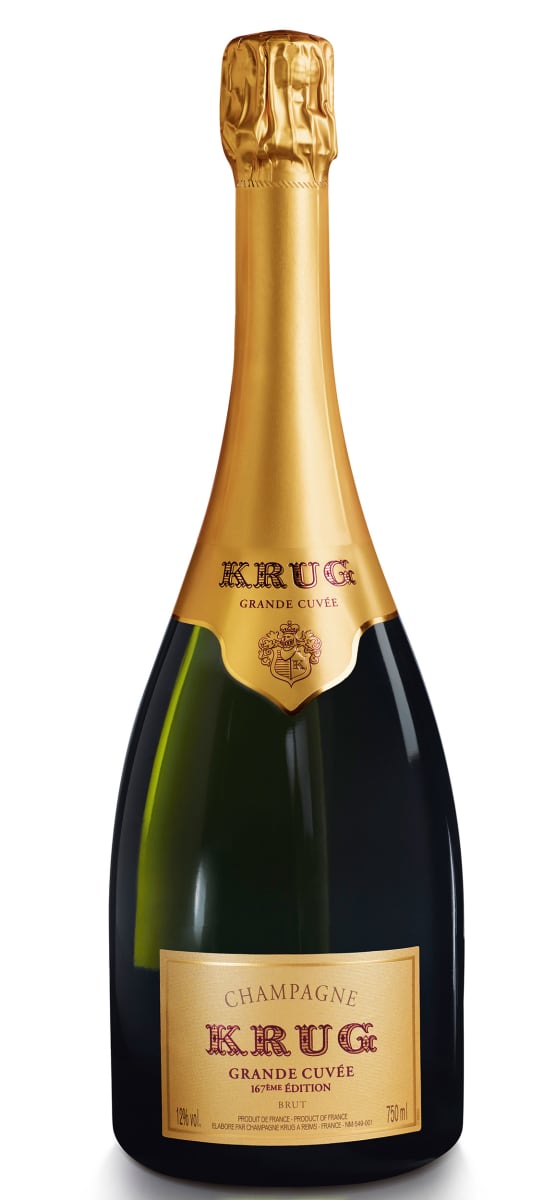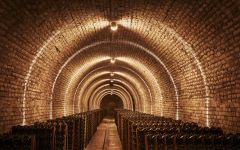Krug Grande Cuvee Brut (167th Edition)
-
James
Suckling -
Wilfred
Wong -
Robert
Parker - Decanter
-
Wine
Spectator -
Wine
Enthusiast -
Wine &
Spirits -
Connoisseurs'
Guide



Product Details
Your Rating
Somm Note
Winemaker Notes
Deep golden colored and fine, vivacious bubbles, predicting fullness and elegance. Aromas of flowers in bloom, ripe & dried fruit, marzipan, gingerbread and citrus fruits. Flavors of hazelnut, nougat, barley sugar, jellied and citrus fruits, almonds, brioche, and honey.
Krug Grande Cuvee lends itself to a wealth of culinary combinations, from an extra-mature parmesan to turbot a la truffe. It can be enjoyed with ham, oysters, shrimp, Indian or Moroccan food, as well as with desserts like carrot cake and cheesecake.
Professional Ratings
-
James Suckling
A rich and dense Champagne with complexity and decadence, in a fresh and agile way. Very driven and energetic with praline, cooked apples and hints of honey. Some bread dough, but subtle and vivid. Very tight and focused. Racy and direct. Bright edition. Very fine textured. Youngest wine in the blend is 2011. Edition 167. Drink now.
-
Wilfred Wong of Wine.com
Krug Grande Cuvée always comes to the table in a big way. From one of the most prestigious Champagne houses, this wine is consistently a top performer. Creamy, complex, and exotic, it is a perfect choice with the grandest of meals. (Tasted: October 10, 2016, San Francisco, CA)
-
Robert Parker's Wine Advocate
Compared to Krug's 160th edition, the bright golden-yellow colored NV Grande Cuvée 166ème Édition (ID117010) is still a baby that shows the chalky and fruity features of a young white Burgundy intermixed with notes of Schwarzwälder Kirsch (dark cherries with black chocolate) and floral (ammonia) flavors on the pure, fresh and elegant yet intense and still yeasty brioche nose with its ripe apple aromas and refreshingly bright (lemon juice) overtones. Round, wide and very elegant yet also straight and tense on the palate, this 2010-dominated cuvée is very delicate, fresh and chalky but also dense and lush in its vinous texture. The finish is well-structured, fresh and persistent, indicating great complexity and vibrancy. However, I would wait at least another three years, during which time the 166th edition will gain even more finesse and quiet. The 166ème Édition is composed of 140 wines from 13 different harvests between 1998 and 2010, and it's a blend of 45% Pinot Noir with 39% Chardonnay and 15% Pinot Meunier, the latter of which provides the vivacity that the Chardonnay from the Côte des Blancs surprisingly didn't have in 2010, a vintage that was marked by its "tumultuous climate," as Eric Lebel writes. Tasted in New York in November 2018.
Rating: 96+ -
Decanter
The rich nose is reminiscent of Japanese seaweed crackers with its insistent, breezy saltiness. The palate shows more savouriness, displaying an almost elastic autolytic depth that draws you in towards the salty miso and yeast core before bouncing you back to the breezy, lemony atmosphere like a vinous bungee. It is that roasted, nutty, salty richness that makes you take another sip. Drinking Window 2020 - 2030
-
Wine Spectator
This mouthwatering Champagne is intense, from the floral- and spice-laced nose to the racy frame of acidity to the expansive flavors of grilled nut, mandarin orange peel, black currant and coffee. Stands out for finesse rather than power, with an enticing finish that brings you back for another sip. Disgorged January 2018. Drink now through 2027
-
Wine Enthusiast
As its name indicates, this is the 167th blend of this producer’s famed Grande Cuvée. Based upon an enviable range of reserve wines, the blend has maturity that is just right, balancing fruit as well as the toast. It is rich and ready to drink.
-
Wine & Spirits
As grand as its name would suggest, this is a complex and substantial blend, based on the 2011 vintage. Eric Lebel included reserve wines going back to 1995, providing 42 percent of the final blend. In the mix of 191 individual lots, there’s a lot of flavor complexity, layering hazelnut, white flowers, exotic fruit, hints of butterscotch and toast. There’s also an earthy, meaty tone, like mousse truffé, which is what you might serve with it.
-
Connoisseurs' Guide
Non-vintaged though it may be, this wine has in the past shown as one of the older cuvees in our tastings, and so again does it do so here. This time, as one expects of Krug, the aged, toasty, minerally character is accompanied by bright, acid-braced, still evident fruit. One might quibble about a bit of chalkiness in the finish.









Krug has always lived up to its reputation as the first and only Champagne House to create exclusively prestige Champagnes every year since its foundation.
The House was established in Reims in 1843, by Joseph Krug, a visionary non-conformist with an uncompromising philosophy. Having understood that the true essence of Champagne is pleasure itself, his dream was to craft the very best Champagne he could offer, every single year, regardless of annual variations in climate. Paying close attention to the vineyard’s character, respecting the individuality of each plot and its wine, as well as building an extensive library of reserve wines from many different years allowed Joseph Krug to fulfil his dream.
With a very original approach to Champagne making, he decided to go beyond the notion of vintage to create the most generous expression of Champagne, every year. Thus, he founded a House in which all Champagnes are of the same level of distinction.
Six generations of the Krug family have perpetuated this dream, enriching the founder’s vision and savoir faire.
Further elaborating on the notion of individuality, for Krug’s Cellar Master Julie Cavil, each plot of grapes, through its wine, is like a single ingredient to a chef: carefully selected, and critical to the final composition. Each year, Krug honors this philosophy by inviting chefs from around the world to interpret a single ingredient, crafting unexpected recipes to pair with a glass of Krug Grande Cuvée or Krug Rosé. This year’s ingredient is the Onion.
The unspoken onion is a key component of almost every fundamental recipe from stocks, sauces and stews to baked goods and roasts. Its multifaceted expressions beautifully marry both the fullness of flavors and aromas of Krug Grande Cuvée the elegance and boldness of Krug Rose.

A term typically reserved for Champagne and Sparkling Wines, non-vintage or simply “NV” on a label indicates a blend of finished wines from different vintages (years of harvest). To make non-vintage Champagne, typically the current year’s harvest (in other words, the current vintage) forms the base of the blend. Finished wines from previous years, called “vins de reserve” are blended in at approximately 10-50% of the total volume in order to achieve the flavor, complexity, body and acidity for the desired house style. A tiny proportion of Champagnes are made from a single vintage.
There are also some very large production still wines that may not claim one particular vintage. This would be at the discretion of the winemaker’s goals for character of the final wine.

Associated with luxury, celebration, and romance, the region, Champagne, is home to the world’s most prized sparkling wine. In order to bear the label, ‘Champagne’, a sparkling wine must originate from this northeastern region of France—called Champagne—and adhere to strict quality standards. Made up of the three towns Reims, Épernay, and Aÿ, it was here that the traditional method of sparkling wine production was both invented and perfected, birthing a winemaking technique as well as a flavor profile that is now emulated worldwide.
Well-drained, limestone and chalky soil defines much of the region, which lend a mineral component to its wines. Champagne’s cold, continental climate promotes ample acidity in its grapes but weather differences from year to year can create significant variation between vintages. While vintage Champagnes are produced in exceptional years, non-vintage cuvées are produced annually from a blend of several years in order to produce Champagnes that maintain a consistent house style.
With nearly negligible exceptions, . These can be blended together or bottled as individual varietal Champagnes, depending on the final style of wine desired. Chardonnay, the only white variety, contributes freshness, elegance, lively acidity and notes of citrus, orchard fruit and white flowers. Pinot Noir and its relative Pinot Meunier, provide the backbone to many blends, adding structure, body and supple red fruit flavors. Wines with a large proportion of Pinot Meunier will be ready to drink earlier, while Pinot Noir contributes to longevity. Whether it is white or rosé, most Champagne is made from a blend of red and white grapes—and uniquely, rosé is often produce by blending together red and white wine. A Champagne made exclusively from Chardonnay will be labeled as ‘blanc de blancs,’ while ones comprised of only red grapes are called ‘blanc de noirs.’
